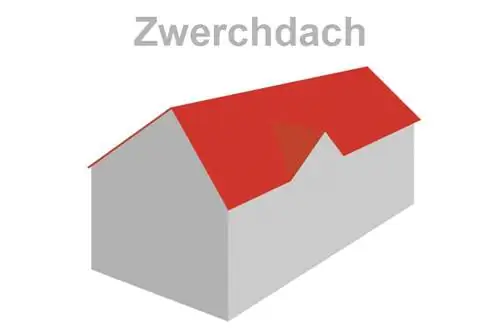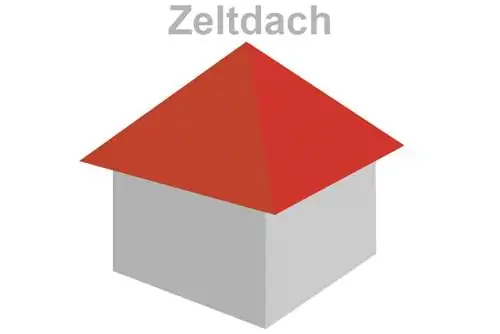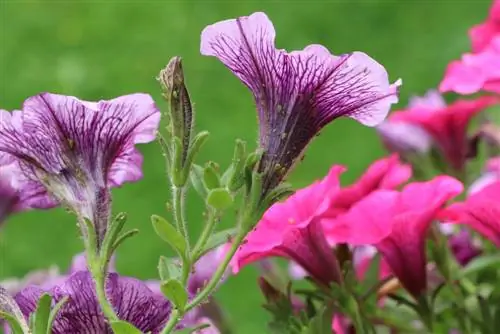- Author admin [email protected].
- Public 2023-12-17 03:39.
- Last modified 2025-01-24 12:45.
The cotoneaster or also known as the medlar is an evergreen ground cover. The botanical name is Cotoneaster radicans. The ground cover is very popular in gardens or on graves because the growth characteristics and care of the plant are very frugal. However, the Cotoneaster radicans can reach a width of 70 cm, which requires constant re-pruning. Beautiful flowers appear between May and June.
Origin
The Cotoneaster radicans originally comes from China and has established itself in Germany as an ideal ground cover that can beautify gardens with its evergreen properties.
Appearance
The ground cover has many small leaves that appear shiny and cover the woodiness. In May and June the cotoneaster blooms and produces small white flowers. In late summer, these many small flowers turn into small berries that are not suitable for consumption. The berries shine out of the evergreen ground cover in a rich red and brighten up the garden for a long time with a colorful blaze of color.
Sowing
Sowing is done using seeds that are available in every well-stocked nursery. You can also purchase the Cotoneaster radicans pre-prepared as a plant.
Location
The cotoneaster is a very tolerant plant that has few demands. The location where the plant feels comfortable cannot be clearly defined. It grows in shady and sunny areas and can certainly be described as a location-independent plant. However, if the Cotoneaster radicans are planted in the shade, this will be at the expense of the flowering. You should therefore consider in advance whether the ground cover should have increased or reduced flowers. However, the task as a ground cover is given in every location.
Plants
The cotoneaster can be planted in a pot, in a bed or outdoors. By planting Cotoneaster radicans you can wonderfully prevent weeds and continue to protect the soil from frosty temperatures.
Pouring
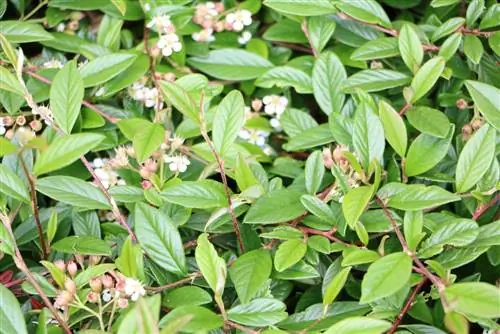
The Cotoneaster radicans copes very well with short-term drought but also with continuous rain. However, waterlogging is something that the Cotoneaster radicans has difficulty dealing with. Therefore, make sure that the soil is well-drained. Once you plant the Cotoneaster radicans, the plant must be constantly watered sufficiently. However, if the ground cover is no longer a young plant, it is usually sufficient to supply the plant with water.
Fertilize
In spring it is recommended that you fertilize the Cotoneaster radicans to maintain the growth of the plant. Since it is very difficult to get to the soil, compost is rather unsuitable as fertilizer. You can use liquid fertilizer or alternatively nettle manure for nutrient administration.
Cutting
It is only necessary to cut it back to your liking if the ground cover needs to be shaped. However, if the Cotoneaster radicans does not have a disturbing location, pruning is not necessary. Tip: If you prune the Cotoneaster radicans, the best time is before August. If you cut the cotoneaster after August, the plant will no longer have time to sprout, which would have a negative effect on the plant.
Wintering
You don't have to worry about much when wintering. Due to its origin, the Cotoneaster radicans can tolerate temperatures down to -30 °C. However, what causes damage to the plant is frost. So if temperatures are low below zero and drought occurs, the ground cover should be covered with straw or brushwood.
Propagate
The medlar can be propagated in three ways. You can propagate by sowing again. Cuttings or cuttings are also effective for propagating Cotoneaster radicans.
Diseases and pests
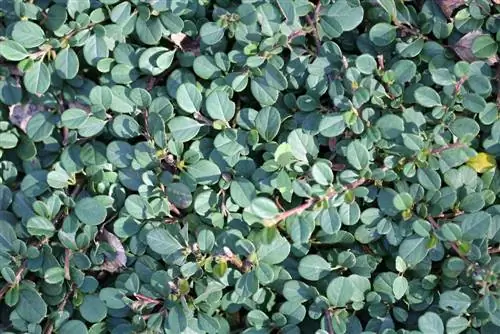
The loquat is very susceptible to so-called fire blight. This disease is caused by a bacteria. However, this disease is completely harmless to humans. However, it poses a serious threat to pome fruits. The fire blight cannot be eliminated. The plant must therefore be removed. Attention: Fire blight is a disease that must be reported in Germany. The authorities will then decide how the plant will be disposed of. You can recognize fire blight by the following features:
- Leaves and flowers are discolored, often turning brown and later black
- Discoloration can also be seen on the shoots
- The clear characteristic of fire blight is the curvature at the shoot tips
- Even if the plant wilts quickly, the suspicion of fire blight is very likely
- clear characteristic of fire blight, when a slimy substance comes out in droplet form from injuries to the plant
Tip:
Since the ground cover is often affected by fire blight, you should definitely avoid planting it in the immediate vicinity of fruit trees.
Summary
The Cotoneaster radicans is a very beautiful ground cover that surprises with red, plump berries after flowering. Below you will find all the properties in detail:
- Growth width up to 70 cm
- adult plants require no care and live frugally on rainwater
- hardy down to minus 30 °C
Frequently asked questions
Can Cotoneaster radicans be combined with other plants?
Since the plant is a ground cover, close planting is not possible. Ground cover plants should be combined with other ground cover plants to achieve a uniform appearance in the garden.
Can the gap be filled with bark mulch during the growth phase?
Once the Cotoneaster radicans is planted, the plant must first take on its properties as a ground cover and grow accordingly. Filling the gaps with bark mulch is not very recommended to prevent weeds from growing in these areas. You could add complex fertilizer during the plant's growth phase, which will make the Cotoneaster radicans grow faster. However, the resulting weeds must always be weeded by hand.
Can Cotoneaster radicans produce foliage in autumn?
Yes, every evergreen plant can lose leaves over the course of its life, which turn brown and later fall off as foliage. This process is completely normal and does not need to scare you. If the conditions in the previous year were very stressful for the plant (constant rain, persistent drought) then the plant may produce more leaves than in previous years. One consolation is that all the leaves that have been shed will grow back next spring.
What you should know about the medlar in brief
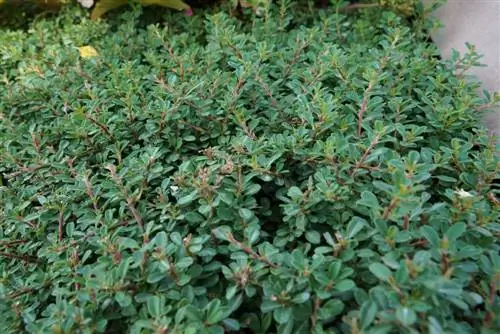
A big advantage of the loquat: its leaf canopy is so dense that the weeds underneath don't get any light and don't grow. Eight plants are enough to cover one square meter and suppress weeds. The flowers are rather inconspicuous, but the bright red fruits are a beautiful winter decoration. The plant is evergreen, so it retains its numerous, small leaves even in winter.
- The carpet mistletoe is easy to care for and undemanding. It grows in both the sun and the shade and is used everywhere.
- It can cope with almost all soil conditions. The medlar requires little moisture and can cope well with drought.
- If the plants spread too much, they can be easily pruned.
A cut like this is due approximately every three years. You cut off what is no longer needed. The plant recovers very quickly and continues to grow happily. The cut shoots can be used immediately for propagation. They usually root quickly.
- The carpet mistletoe, as the name suggests, forms true plant carpets. However, it looks boring if only one type is used.
- You should bring some variety to such an area, even if it's just through different varieties that have different colored foliage, flowers or fruits.
- The medlar is an easy-care ground cover, but by no means the only one.


